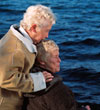News
The perils of aging while gay
By Tomas Guerra, Special to 365gay.com
Monday, March 03, 2008

When Gayle had a stroke one Sunday evening nine years ago, she was rushed to Hennepin County Medical Center’s emergency room, Minnesota’s third largest hospital.
But when Gayle (a senior trans woman) got there, she was told that in order to receive treatment, she would have to re-assume her old identity: She had to become Glen if she wanted to be helped.
Gayle did not protest. She wanted her life to be saved. But when she was taken to the Veterans Administration Hospital for follow-up care, she was forced to do the same: she was told she’d be Glen for every medical provider who worked there.
More recently, an openly gay man who had no family or friends hanged himself in a room of a nursing home in an East Coast city; because others on his floor were made uncomfortable by his sexual orientation, the 79-year-old had been moved to a floor for patients with disabilities and dementia. The resulting stress made him too depressed to live.
As the elderly population swells—it is expected to double from 44 million to 90 million in the next 25 years—abuses like these and the general lack of humane care for LGBT elders are becoming more and more visible.
According to statistics from SAGE (Service and Advocacy for GLBT Elders), the senior LGBT population will multiply from 3 million to 6 or 7 million in the next 25 years, and their communities are not prepared to give them proper housing and the appropriate healthcare. Researchers and activists see a crisis looming.
“The number of seniors could become a kind of crisis like the HIV epidemic in the next five to 10 years, and there is no structure to deal with it. They’re not ready for us,” said Amber Hollibaugh, senior strategist for the National Gay and Lesbian Task Force.
In Milwaukee County, the Department of Aging found that the city’s LGBT seniors were five times less likely than other elders to access needed services because of fear of discrimination.
Michael Adams, executive director of SAGE, added that because Social Security survivor benefits and Medicaid are built around marriage, there is also latent discrimination at the federal level which heavily impacts older same-sex couples.
Adams said that in addition to discrimination, the growing LGBT senior population faces more challenges because it doesn’t have the same support network as most other seniors: “Eighty percent of the community we work with (in New York) doesn’t have children, and 50 percent have no family members to reach in case of an emergency.”
But the landscape is starting to change for the elderly, and as they live longer and grow in numbers, and as post-Stonewall baby boomers start their retired lives, there is emerging a new generation less afraid to speak out for their rights and ready to challenge the status quo in the retirement community.
The survey “Gay and Graying: Concerns for the Future,” just released by Community Marketing Inc., found 70 percent of its lesbian and gay respondents over age 40 with concerns about losing the ability to care for themselves. And the majority also feared becoming sick or disabled.
So how will society, the federal government, healthcare providers and nursing homes adjust to their urgent needs? The federal government has begun making some improvements for LGBT seniors. The Bush administration, for example, admitted SAGE as the first LGBT delegate to the White House Conference on Aging in 2005.
Also, for the first time ever, AARP will sponsor and present SAGE’s National Conference on Aging “It’s about Time: LGBT Aging in a Changing World,” to be held next October in New York.
LGBT aging projects are also branching out in cities such as Boston, New York, Chicago and Atlanta. And Stonewall Communities, a non-profit organization from Boston, has partnered with Abbott Real Estate to build “Stonewall Audubon Circle,” 53 one- and two-bedroom homes which feature assisted-living centers for older gay people, the first of its kind.
But help needs to come from within the LGBT community as well. Hollibaugh, who authored the first LGBT training curriculum for nursing homes, emphasized that to overcome these challenges, it is vital to build a bridge between LGBT elders and younger generation, because this sort of discrimination is likely to continue, and younger activists need to help.
“The bulk of us are not rich, and if the community doesn’t respond, we will be without choice,” she said.
Nine years after her tragedy Gayle is still crippled, but she has managed to recover enough to live independently in a suburb near Minneapolis.
When Gayle and her friends talk about her experience with the medical personnel at the county and VA hospitals, she feels sad and angry.
And when they ask her, “Why didn’t you protest?” she simply responds: “I didn’t have any choices. When you’re not sure if you’re going to live or die, you’re just going to do what they tell you to do.”
